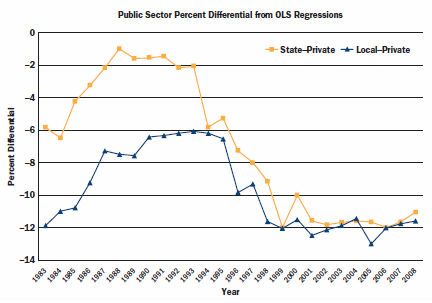On the ever popular subject of whether public employees are coddled and overpaid, EPI steps in with a new bit of research from Jeffrey Keefe of Rutgers today. I’ll spare you the suspense and get right to the results:

This is pretty much what you’d expect. Public employees get a bigger share of their compensation in benefits than private sector employees (34% of total comp vs. 26-33%), and because of this the lower rungs of the public sector ladder get paid a bit more than their private sector counterparts. Anyone with a college education or more, however, is paid far less, and this brings the overall average for the public sector a bit below the private sector.
In a separate calculation that controls for full-time status, education level, years of experience, age, gender, race, employer organizational size, industry, and hours worked, the report concludes that public employees are compensated 2-7% less than equivalent private sector employees.
Take from this what you will. Obviously it’s hard to know for sure if all the controls are properly accounted for, and you can decide for yourself if it’s fair for high school and community college grads to make more working on the taxpayer dime than they would in private industry. Overall, though, this is yet another study that tells us the numbers are pretty close no matter how you slice them. It’s always easy to find a few horror stories (usually cops or firefighters who works fantastic amounts of overtime), but in the aggregate it doesn’t look like there’s much evidence that government jobs are overpaid compared to private jobs.















